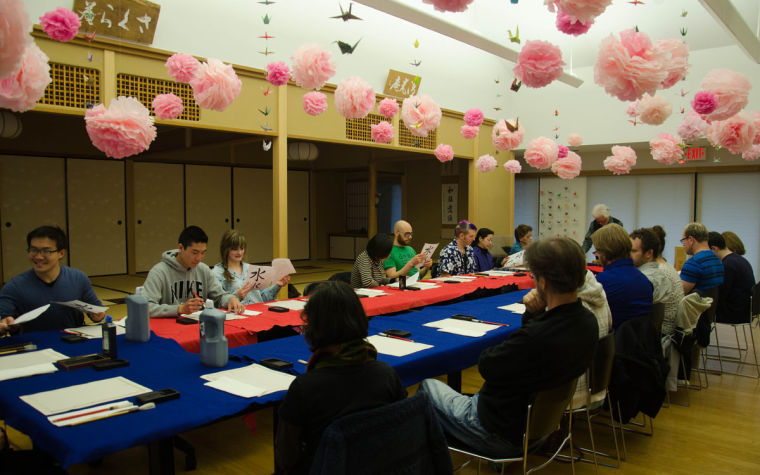Calligraphy classes share Japanese culture with CU community
April 8, 2014
Calligraphy can be considered a silent waltz with the brush. Shozo Sato, Japan House founder and professor emeritus of the University, takes the lead.
Sato has returned to campus to teach a series of calligraphy classes at the Japan House.
With a degree in multiple Japanese arts — including tea ceremony, painting, Kabuki dance and flower arrangement — Sato aims to further the understanding of Asian culture on campus through his experiences and expertise.
Sato said that different cultures express their traditions uniquely, and calligraphy functions as a display of Japanese culture.
“Learning a culture is like learning another language,” he said. “In a sense, this calligraphy class is comparative culture of how to create a line (between cultures).”
Get The Daily Illini in your inbox!
The first class was held Monday evening, and the series will continue on April 14, 21 and 28. Each class will begin at 5:30 p.m. and the cost is $20 for Tomonokai members and students, and $25 for others. A $5 fee may be charged for brushes and ink, if needed.
Since the Japan House’s establishment in 1975, Sato began teaching these calligraphy classes early on as part of the house’s programming and overall mission, said Cynthia Voelkl, Japan House assistant director.
“The mission of Japan House is really to teach and explore the traditional arts of Japan,” Voelkl said. “By exposing people to the traditional arts of that culture, the idea is that you become more aware and tolerant of one culture and it kind of opens you up to all cultures.”
The Japan House, though small, brings many elements of Japanese culture to campus including pottery, gardening and origami.
As one of the key traditional arts of Japan, participants can expect to practice hands-on techniques for calligraphy during the class. However, because of the challenging nature of the class, Sato has to make a special announcement before the workshop begins.
“I have to touch your hand,” he said. “By doing so, you know when to give pressure to the brush and pull up and all that. It takes a few years of experience to learn. But if somebody guides you, you learn instantly.”
According to Sato, calligraphy differs from Western writing because of the discipline it requires. Sato said each ideogram has certain directions to follow, and therefore, “you cannot do anything you want.”
It is only until the basic skill is learned that someone can move a little “freer” and input their own personality. But he said this cannot be done until someone can answer the fundamental question of “Who am I?” through Zen philosophy.
“What is personality if you don’t know who you are and don’t know how to express yourself?” Sato asked. “That is the core of Zen as well. Until you know who you are, constantly, you are bound against a wall.”
Students will achieve this by choosing a Zen philosophy statement that represents their lifelong motto, according to Sato.
“(It is) trying to enlighten yourself through what you’re writing, and that’s the whole idea,” he said.
Sato said he discovered his personal Zen statement when he was 20-years-old, after trying to find himself “through different mediums of art since the age of 4.” Sato said his Zen statement is: “The way of art is the way of Buddha.”
Sato said his Zen statement can be explained in reference to Buddhism.
“(It’s) going back to the purity in the process of creativity. Through the concentration of actions, you will be purified and will find success in your work. That’s why I like this statement,” Sato said.
But apart from what he can teach about calligraphy and Zen philosophy, Sato said he cherishes the enjoyment he sees from his students the most.
“The excitement in their eyes is something you cannot buy with money,” he said. “That’s love of teaching, love of students, to see what they can do. How they can be exposed to another culture, another medium. That excitement in their eyes is something you can’t find in any other place.”
Sato’s experience and skills have continued to bring students and community members back to learn more about the art.
“(I come back for) Shozo. It’s his peacefulness. His Zen-ness,” said June Volkening, a regular student of the class since last fall. “I want to learn calligraphy and hopefully I can put some of the strokes I learn on my pottery.”
For Sato, the University is not like any other — it is his “second home.”
“Here, I established life in America,” he said. “I established the Japan House. I established understanding of Asian culture on this campus. So, this is my second home in my life, and my first home in America. But I don’t want to just sit in my own home but share what I have learned and gained in knowledge.”
Stephanie can be reached at [email protected].







